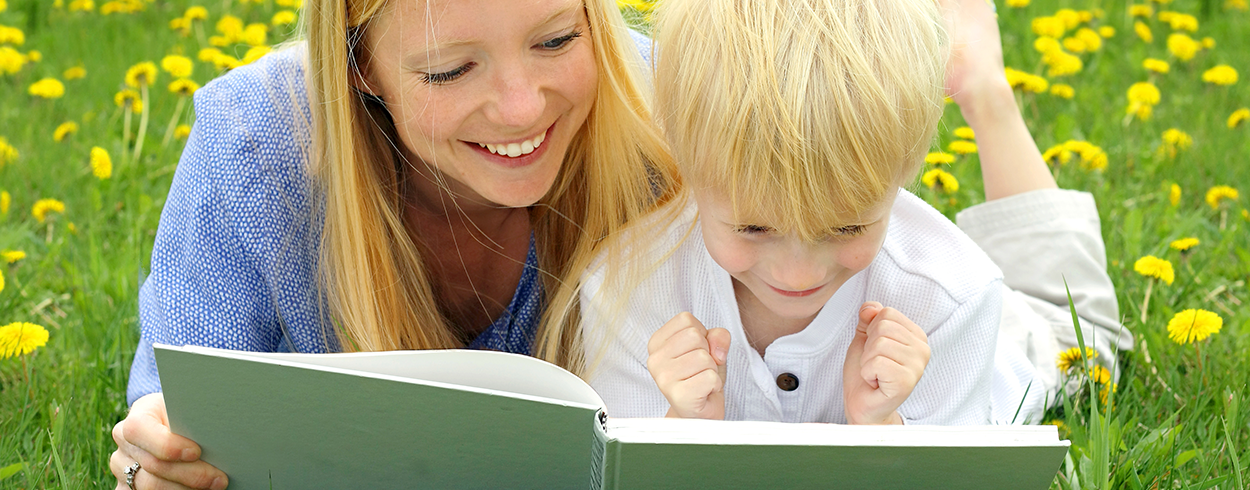Language Arts
Explore Language Arts activities
Preschool children’s use of language skills to listen and speak, as well as their understanding of reading and writing, will be critical to their academic success in the early elementary grades. Young children are learning how to communicate what they want their listeners to know, how to play with language, how to interact with books, how to understand and tell stories, and how to begin to write as a form of communication. Families can support children as they joyfully express themselves, explore books and stories, experiment with writing, and listen and learn together.
Explore the Language Arts below.
As you turn pages in a book, they are learning how books work. Reading has a direction that goes from top to bottom and left to right. When exploring books with your child you are laying the groundwork for reading.
You are never to young to write. While your child's scribbles may not look like writing to you, they are the first steps to being a life-long writer. Over the years, these marks will begin to look more and more like letters.
When we make predictions, we form ideas about the future based on what we already know or believe. A predictable book is one that features patterns, sequences, and connections in the illustrations or words that enable children to guess "what comes next.?" in_ the story.
Retelling stories is important! When a child can tell you some or all of what happened in a story, they show you that they listened, understood and can use their language and vocabulary skills to tell you what they remember.
Children are full of questions, some are easily answered but some are an excellent opportunity for further investigation. Working with your child to find the answers to questions allows your child to be a successful life-long learner.
Rhyme is found in poetry, songs and children's books. Awareness of groups of sounds in words is an important pre reading skill. Learning rhyme through songs, books and finger plays can help your child to read.
Your child will communicate needs, ideas and thoughts in a variety of ways. As caregivers, we need to foster children's natural curiosity and creativity through discussions, asking and answering questions, and giving choices, helping them to express themselves in ways others will understand.
There is a strong relationship between children's understanding of the sounds of language and children's early literacy and readiness to read. These sounds include alliteration, words that start with the same sound and recognition of syllables, Segments of speech.
By providing opportunities for children to engage with books and writing on a regular basis you increase children's motivation to be life-long readers and writers.
Reading a book to your child is not an experience where you only read as your child listens. From the moment you look at the cover of a book, a conversation of questions and answers should begin. Doing so increases your child's interest and comprehension (understanding) of the story.
When young children draw and scribble, the scribbles will become letters and finally words.
By including the print that is used in the home and in the world, children interact with writing as they see adults doing daily, they see firsthand there are very different ways to use print. This sparks an interest that leads to learning.
Help your child understand that print carries a message by showing them pictures and symbols along with the printed word. Children will begin to make the connection that pictures give us information about words and words do not change ( do-g is always "dog").
Hearing and making some letter/sound matches is one of the building blocks that will lead to future success in reading. For young children this skill begins when you play games, sing songs and read books that identify all kinds of sounds such as animals or automobiles.
We write to accomplish many tasks - lists, letters, checks, applications, thank you notes.
We learn best from what we already know. Children relate new situations with past experiences. If your child creates a zoo, they base their creation on the past experience of having been to or seen a zoo. Our knowledge of past experiences is a key to future learning.
Have you ever met 52 new people and tried to remember all their names? That's what it's like for your child as he navigates his way through these strange symbols we call the alphabet.
Children learn best through what they know and feel comfortable with. Using familiar labels and signs allows your child to have success in acquiring the skills necessary to learn to read.
Being able to communicate information through writing, speaking or through signs and body language opens up a world of opportunities to your child. The conversations your child has with adults and peers in the preschool years shapes their ability to communicate throughout life.
Take time to talk with and listen to your child in your home language. You might be surprised at the answers!
